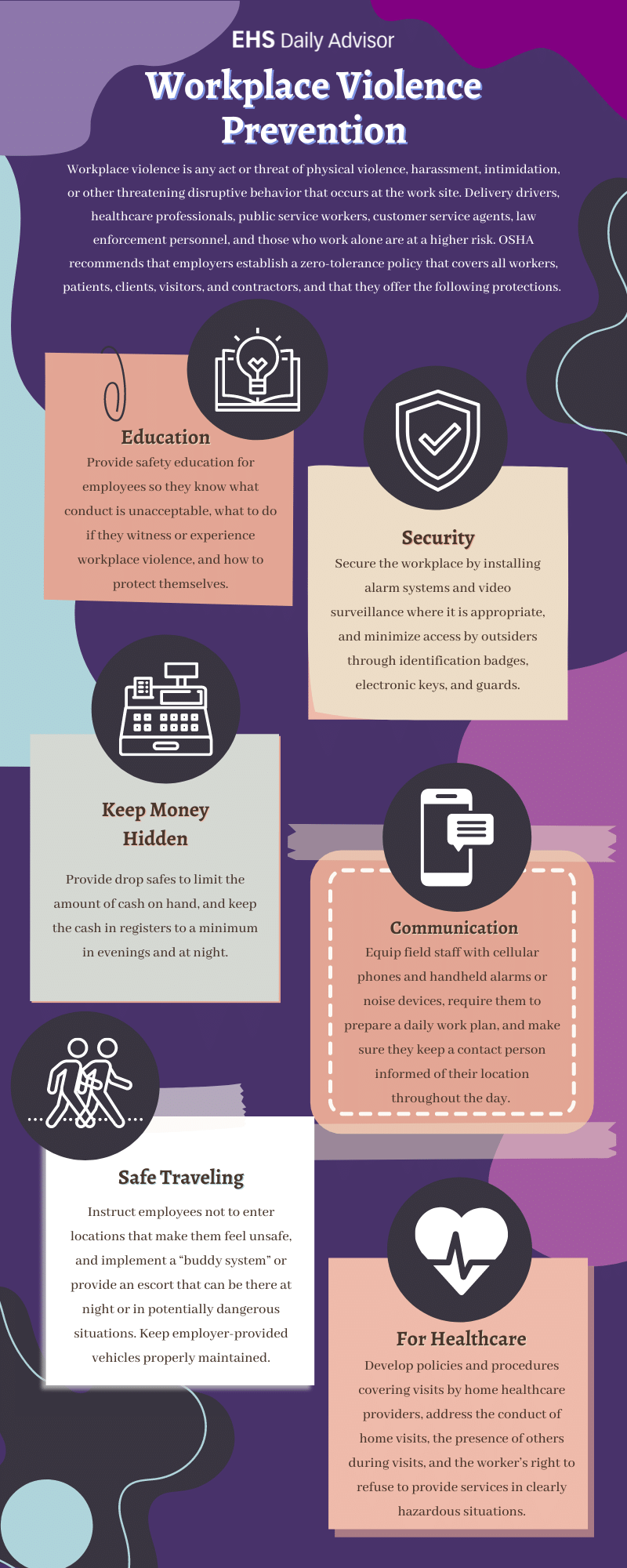Discovering Reliable Techniques and Methods for Carrying Out Workplace Physical Violence Avoidance Programs in Organizations
Workplace physical violence remains a critical problem for organizations, demanding the implementation of robust avoidance programs. Comprehending the dynamics of office violence and the parts that contribute to reliable avoidance is crucial for fostering a risk-free setting.
Understanding Office Violence
Recognizing workplace physical violence is necessary for promoting a productive and safe environment. Office physical violence incorporates a variety of actions that can occur in different types, consisting of physical attacks, dangers, verbal misuse, and even harassment. Such incidents can develop from interpersonal disputes, occupational stress factors, or outside aspects and can considerably disrupt organizational operations.
The effects of workplace violence expand beyond prompt physical damage; they can additionally cause emotional trauma for targets, reduced staff member spirits, and enhanced absence. Moreover, companies might face lawful responsibilities and reputational damages as a result of violent cases. Identifying the different types of office violence is critical in order to effectively address and reduce the threats related to these actions.
Efficient monitoring of work environment physical violence begins with comprehending its underlying reasons. Eventually, a thorough understanding of office physical violence is a fundamental step towards producing a secure and durable business society.
Key Elements of Prevention Programs
A successful workplace physical violence avoidance program is built on several key components that jointly create a much safer atmosphere for workers. A detailed and clear plan outlining the organization's dedication to preventing work environment violence is crucial. This policy should specify what comprises office physical violence and the effects for offenses.
2nd, risk assessments need to be routinely carried out to identify potential hazards and susceptabilities within the office (california workplace violence prevention). Recognizing the certain dangers connected with an organization's environment permits customized treatments
Third, event reporting devices have to be developed to encourage employees to report any kind of worries or occurrences without concern of retaliation. This openness cultivates a culture of security and responsibility.

Lastly, leadership dedication is critical; monitoring has to proactively participate and sustain in avoidance efforts. Their involvement sets a tone of severity relating to the issue and urges a cumulative technique to security.
Training and Education Techniques
Implementing reliable training and education and learning techniques is vital for outfitting staff members with the knowledge and skills needed to acknowledge, prevent, and react to work environment physical violence. Comprehensive training programs need to be tailored to the details requirements of the company and its labor force, taking into account the special risks connected with different workplace.
Training ought to encompass numerous topics, consisting of the identification of caution signs, de-escalation strategies, and the significance of cultivating a supportive office culture. Engaging approaches such as interactive workshops, role-playing circumstances, and situation researches can enhance discovering retention and encourage positive participation amongst workers.
Furthermore, ongoing education and learning is necessary. Frequently scheduled correspondence course make certain that workers stay notified regarding the most up to date finest techniques and behavior trends associated with work environment physical violence. Incorporating comments systems, such as studies or emphasis groups, can assist organizations examine the effectiveness of their training efforts and make essential changes.
Reporting and Response Systems
Efficient reporting and reaction mechanisms are vital for dealing with incidents of workplace physical violence promptly and efficiently. Organizations has to establish clear procedures that encourage employees to report cases without concern of retaliation. These systems need to consist of several reporting networks, such as anonymous hotlines, why not try these out e-mail, and in-person reporting options, ensuring that all workers really feel risk-free and sustained when revealing incidents.
Additionally, it is important to educate staff members on how to use these reporting systems effectively. Training needs to emphasize the significance of timely reporting, as very early treatment can prevent rise and advertise a much safer workplace. Upon obtaining a record, organizations ought to have an organized action plan that consists of instant evaluation of the scenario, assistance for affected individuals, and involvement with police if necessary.
In addition, organizations should guarantee that examinations are carried out promptly and extensively, adhering to lawful and ethical criteria. Transparency in the feedback procedure can construct depend on among workers and show the organization's dedication to safety - california workplace violence prevention. Normal reviews of the coverage and reaction systems will certainly assist recognize areas for enhancement, ultimately improving the overall efficiency of office violence avoidance programs
Assessing Program Performance
Assessing the performance of workplace physical violence avoidance programs is crucial for ensuring they fulfill their intended goals and adjust to the evolving requirements of the company. This procedure involves an organized assessment of both quantitative and qualitative information to determine program effect, staff member perceptions, and total office safety.
Secret metrics for assessment might include occurrence rates of workplace violence before and after program application, staff member responses through surveys, and the usage prices of reporting mechanisms. Regularly scheduled assessments allow organizations to determine voids in their programs and deal with any type of arising threats quickly.

It is necessary to establish clear benchmarks and goals prior to program implementation, which will facilitate a more efficient examination procedure. By continually fine-tuning and keeping an eye on avoidance methods, companies can produce a much safer workplace and significantly reduce the risk of workplace violence. Ultimately, reliable analysis ensures that avoidance programs continue to be responsive and vibrant to the requirements of the workforce.
Conclusion
Finally, the implementation of effective workplace violence prevention programs requires an extensive approach that includes clear plans, normal threat assessments, and robust training. Involving academic methods and available coverage systems enhance worker participation and responsiveness. Leadership dedication plays an important role in cultivating an encouraging organizational society. Continuous examination via comments and case metrics here guarantees recurring refinement and enhancement of these programs, inevitably adding to a much safer and extra resilient workplace.

In final thought, the application of efficient work environment violence avoidance programs requires a thorough strategy that includes clear plans, regular risk assessments, and robust training.